The NVIDIA GeForce RTX 2060 6GB Founders Edition Review: Not Quite Mainstream
by Nate Oh on January 7, 2019 9:00 AM ESTWolfenstein II: The New Colossus (Vulkan)
id Software is popularly known for a few games involving shooting stuff until it dies, just with different 'stuff' for each one: Nazis, demons, or other players while scorning the laws of physics. Wolfenstein II is the latest of the first, the sequel of a modern reboot series developed by MachineGames and built on id Tech 6. While the tone is significantly less pulpy nowadays, the game is still a frenetic FPS at heart, succeeding DOOM as a modern Vulkan flagship title and arriving as a pure Vullkan implementation rather than the originally OpenGL DOOM.
Featuring a Nazi-occupied America of 1961, Wolfenstein II is lushly designed yet not oppressively intensive on the hardware, something that goes well with its pace of action that emerge suddenly from a level design flush with alternate historical details.
The highest quality preset, "Mein leben!", was used. Wolfenstein II also features Vega-centric GPU Culling and Rapid Packed Math, as well as Radeon-centric Deferred Rendering; in accordance with the preset, neither GPU Culling nor Deferred Rendering was enabled. NVIDIA Adaptive Shading was not enabled.
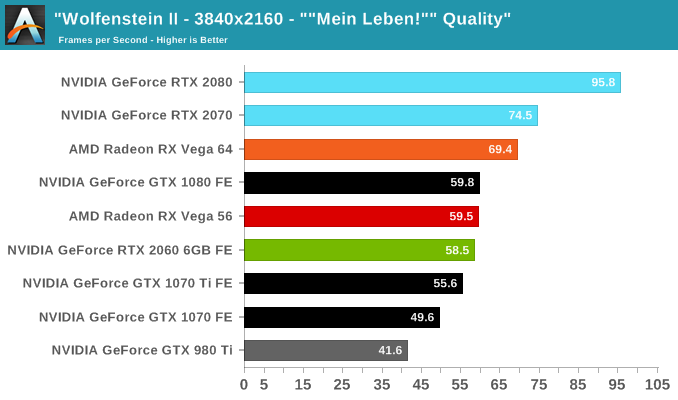


In summary, Wolfenstein II tends to scales well, enables high framerates with minimal CPU bottleneck, enjoys running on modern GPU architectures, and consumes VRAM like nothing else. For the Turing-based RTX 2060 (6GB), this results in outpacing the GTX 1080 as well as RX Vega 56 at 1080p/1440p. The 4K results can be deceiving; looking closer at 99th percentile framerates shows a much steeper dropoff, more likely than not to be related to the limitations of the 6GB framebuffer. We've already seen the GTX 980 and 970 struggle at even 1080p, chained by 4GB video memory.
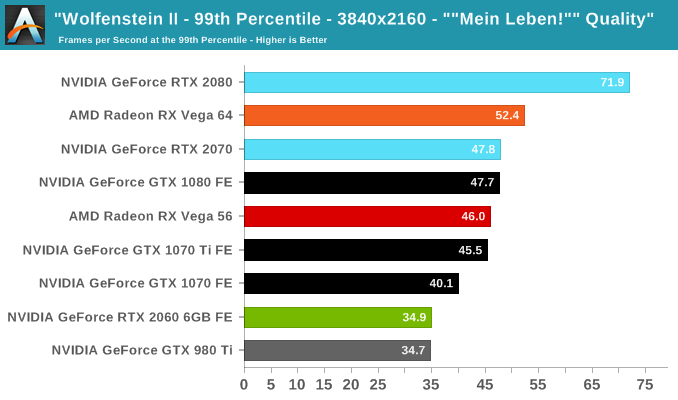
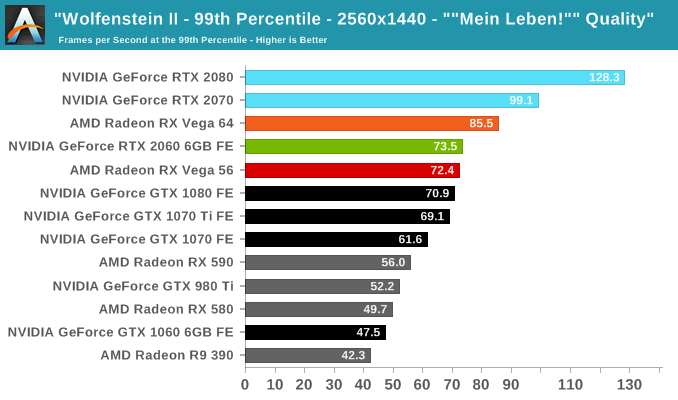
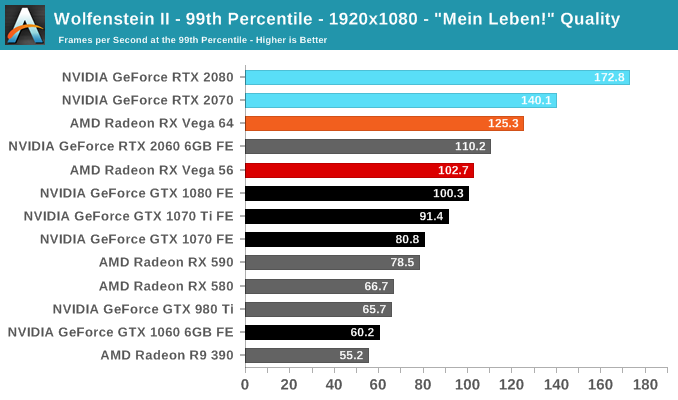


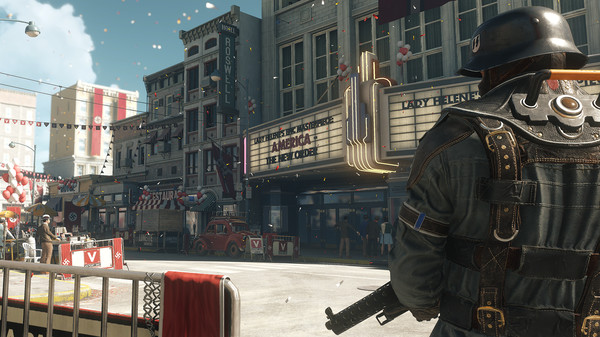








134 Comments
View All Comments
CiccioB - Thursday, January 10, 2019 - link
I would like to remind you that when the 4K interest begun there were cards like the 980TI and the Fury, both unable to cope with such a resolution.Did you ever write a single sentence against the fact that 4K was a gimmick useless to most people because it was too expensive to support?
You may know that if you want to get to a point you have to start walking towards it. If you never start, you'll never reach it.
nvidia started before any other one in the market. You find it a gimmick move. I find it real innovation. Does it costs too much for you? Yes, also Plasma panels had 4 zeros in their price tag at the beginning, but a certain point I could get one myself without going bankruptcy.
AMD and Intel will come to the ray tracing table sooner than you think (that is next generation for AMD after Navi that is already finalized without the new computing units)
saiga6360 - Thursday, January 10, 2019 - link
Here's the problem with that comparison, 4K is not simply about gaming while ray tracing is. 4K started in the movie industry, then home video, then finally games. There is a trend that the gaming industry couldn't avoid if it tried so yes, nvidia started it but its not like nobody was that surprised and many thought AMD will soon follow. Ray tracing in real time is a technical feat that not everyone will get on board right away. I do applaud nvidia for starting it but it's too expensive and that's a harder barrier to entry than 4K ever was.maroon1 - Monday, January 7, 2019 - link
wolfenstein 2 Uber texture is waste of memory. It does not look any different compared to ultrahttp://m.hardocp.com/article/2017/11/13/wolfenstei...
Quote from this review
" We also noticed no visual difference using "Uber" versus "Ultra" Image Streaming unfortunately. In the end, it’s probably not worth it and best just to use the "Ultra" setting for the best experience."
sing_electric - Monday, January 7, 2019 - link
I wish the GPU pricing comparison charts included a relative performance index (even if it was something like the simple arithmetic mean of all the scores in the review).The 2060 looks like it's in a "sweet spot" for performance if you want to spend more less than $500 but are willing to spend more than $200, but you can't really tell that from the chart (though if you read the whole review it's clear). Spending the extra $80 to go from a 1060/RX 580 to a RX 590 doesn't net you much performance, OTOH, going from the $280 RX 580 to the $350 2060 gets you a very significant boost in performance.
Semel - Monday, January 7, 2019 - link
"11% faster than the RX Vega 56 at 1440p/1080p, "A two fans card is faster than a terrible, underperforming due to a bad one fan design reference Vega card. Shocker.
Now get a proepr Vega 56 card, undervolt it and OC it. And compare to OCed 2060.
YOu are in for a surprise.
CiccioB - Monday, January 7, 2019 - link
A GPU born for the computational task, with 480mm^2 of silicon thought for that, 8GB of expensive HBM and consuming 120W more being powned by a chip in the x60 class sold for the same price (and despite the silicon not all being used and benchmarked for the today games, the latter still preforms better, let's see when RTX compute units and tensor will be used for other tasks like ray tracing but also DLSS, AI and any other kind of effects. And do not forget about mesh shading).I wonder how low the price of that crap should go down before someone consider it a good deal.
Vega chip failed miserably at its aim of making any competition to Pascal in both games, prosumer and professional market, now with this new cutted Turing chip Vega completely looses any meaning of even being produced. Each sold pieces is a rob to AMD's cash coffin and it will be EOF sooner than later.
The problem for AMD is that until Navi they will have nothing to go against Turing (the 590 launch is a joke, can't you really thing a company that is serious in this market can do that, can you?) and will constantly loose money in the graphics division. And if Navi is not launched soon enough, they will lose a lot of money the more GPU they (under)sell. If launched too early they will loose money for using a not mature enough PP with lower yields (and boosting the voltage isn't really going to produce a #poorvolta(ge) device even at 7nm). These are the problem of being an underdog that needs latest expensive technological applications to create something that can vaguely being considered decent with respect to the competition.
Let's hope Navi is not a flop as Polaris, or also the generation after Turing will cost even more, after the price have already gone up with Kepler, Maxwell and Pascal.
Great job this GCN architecture! Great job Koduri!
nevcairiel - Monday, January 7, 2019 - link
Comparing two bog standard reference cards is perfectly valid. If AMD wanted to shine there, they should've done a better job.Retycint - Tuesday, January 8, 2019 - link
Exactly. AMD shouldn't have pushed the Vega series so far past the performance/voltage sweet spot in the first place.sing_electric - Tuesday, January 8, 2019 - link
I mean, at that point, then, why bother releasing it? If you look at perf/watt, it's not really much of an improvement over Polaris.D. Lister - Monday, January 14, 2019 - link
@Semel: "...get a proepr Vega 56 card, undervolt it..."Why is AMD so bad at setting the voltage in their GPUs? How good their products can be if they can't even properly do something that even the average Joe weekend overclocker can figure out?
Answer to the first question is: "They aren't. AMD sets those voltages because they know it is necessary to keep the GPU stable under load. So, when you think yourself more clever than a multi billion dollar tech giant and undervolt a Radeon, you make it less reliable outside of scripted benchmark runs.